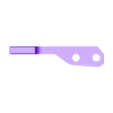The basis for this design is the idea of using 'standard' drivegears for dual drive extruders, combined as simply as possible with a flexible drive shaft.
This version is for the smallest 17 tooth gears used into Sherpa or BMC extruders. Other design are in preparation for 18, 25 and 37 tooth gears, and 3 mm filament.
- It's dual drive.
- It has a lower reduction ratio than the other remote direct drive extruders: higher retraction speed possible.
- It uses available hardware.
- It is open source.
- hardware kits should be available soon.
Since the drivegears have a gear, a single worm screw is the only thing needed to drive them and get a fair stepper motor ratio. This design doesn't need a slant-toothed pinion.
This specific feature makes this design original and unique and this publication protects it against any commercial derivative using the same principle. All existing designs use at least one more gear with a larger diameter than the drive roller and/or a specific gear.
Since the gear and the roller are necessarily the same diameter, we will keep the reduction ratio, whatever the roller's diameter. And having only one gear means also less backlash.
All available rollers are made with the same module of 0.5. So we get about 1.3 mm of extrusion per motor revolution for an 8.5 mm nominal diameter roller. This is ideal because a motor pitch will produce 0.12 mm of material with a 0.4 nozzle, or 0.08 mm for 0.5. This is small enough to be accurate without pushing the microstepping too far.
I recycled the driveshaft and worm screw from a Flexdrive that wasn't totally satisfying: Too much gearing and therefore retraction speed limited to 20 mm/s... And recurrent drive problems that required the printing of several levers. Not to mention that over time the parts become deformed...
A priori the zesty nimble uses a flex shaft of the same diameter, and a worm gear of the same module, but shorter, if someone has the exact dimensions of these parts, I can adapt the design.
This design is the most compact version based on 17 tooth drive rollers (8.5 mm effective diameter, 14 mm length). ATTENTION you need 3 axles of 3 mm x 23 mm and 4 needle cages K3 5-7... Usually these kits are delivered with only 2 cages and 1 or 2 axes. See Ebay or Aliexpress for these parts. There are also brass worm gears, with different inner diameters. So one can fit another model of flex shafts than the one supplied by Flexdrive or Zesty.
You also need 2 bearings for the worm screw. 1 x 685 and 1x MR85 bearings. 2 RS1 versions will be a bit more expensive but maintenance-free.
This remote drive extruder is primarily intended for delta printers where the head mass must be kept to a minimum.
The extruder body can be modified according to the mounting device on the machine. In the basic version, 2 screws of M2.5 X 30 and one of M2.5x 10 are required. It is also possible to secure the flex shaft holder with shorter screws and inserts, if they are not used for mounting.
The lever is pushed by a M3 screw to tune the pressure on the filament. No spring is needed.
The filament is guided by a teflon tube inserted on top of the extruder (as long as you need, up to your filament enclosure if necessary) , and a small lenght of the same tube goes under the extruder into the cooler.
My parameters for Klipper are 1.332 mm/rev, which is 150.12 whole steps per mm of wire.
I was able to adjust the motor parameters (a Nema 17 -23) to reliably get 1500 rpm, so 33 mm/s of retraction speed. The use of a smaller and therefore faster motor is possible, the necessary torque is very limited. Be careful not to program/ajust a too high current on the motor, as this could easily destroy the plastic worm screw if the drive gears are locked... I'm using around 0.3 A @ 12V for a 4 ohms motor rated 1.5A.
The quality of printing is there... I did not notice any really visible defects related to differences in extrusion.
Please contact me for any commercial derivative of this concept.
Some more information on Hackaday

/https://fbi.cults3d.com/uploaders/14574341/illustration-file/57ca9180-196f-4f1a-9315-9c052cce80b5/1.jpg)














